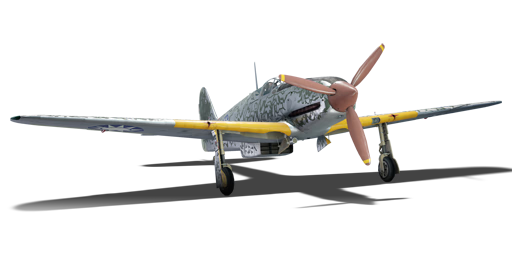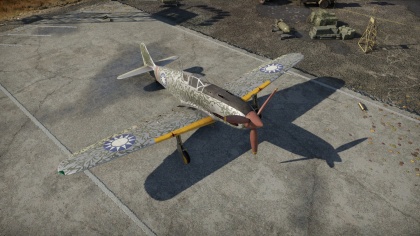Ki-61-I otsu (China)
Contents
| This page is about the Chinese fighter Ki-61-I otsu (China). For other versions, see Ki-61 (Family). |
Description
The ␗Ki-61-I otsu Hien is a rank Chinese fighter
with a battle rating of (AB), (RB), and (SB). It was introduced in Update 1.91 "Night Vision".
Unlike the more manoeuvrable and agile A6M, the Ki-61 is more of what one would call an "energy fighter". Compared to the "Zero" it is faster, has a higher climb rate, and handles better at higher speeds. Armed with four 12.7 mm Ho-103 machine guns and plenty of ammunition, the Ki-61-Ib is a more than capable fighter. It is faster, has a higher rate of climb, and features a better armament. Utilize these three aspects when facing enemy aircraft.
One of the major advantages the Ki-61-Ib has is its climb rate. The stat card may be misleading, but this plane can reach altitudes no enemies will be close to (unless of course, the enemy is another Hien). This allows the Hien to choose when and where it wants to fight. Instead of simply "turning and burning" the Ki-61 is very good at energy fighting, or "boom and zoom". Once at a high altitude the Hien pilot may choose to dive lower to attack an enemy. If the enemy is not destroyed on the first pass, it is recommended to climb sharply and gain altitude. By doing this, the Hien sets itself up for another attack while not being in the range of the enemy's guns.
The Ki-61-I otsu looks akin to the Bf 109 in construction, with its inline engine and armament locations in the nose and wings.
The Ki-61-I otsu utilised four 12.7 mm Ho-103 Japanese machine guns. Generally, they are unreliable and it often takes hundreds of rounds to destroy an enemy plane. This is due to the lack of primer in the rounds themselves. 12.7 mm rounds fired by the M2 Browning may seem to do more damage because they have more primer which dictates how fast the round will exit the barrel. Due to this, it is necessary to get up close to enemies. Aim for the engine, pilot, or fuel tanks if the location is known. Remember to lead with these machine guns, as the rounds are not high velocity.
General info
Flight performance
Describe how the aircraft behaves in the air. Speed, manoeuvrability, acceleration and allowable loads - these are the most important characteristics of the vehicle.
| Characteristics | Max Speed (km/h at 5,000 m) |
Max altitude (metres) |
Turn time (seconds) |
Rate of climb (metres/second) |
Take-off run (metres) | |||
|---|---|---|---|---|---|---|---|---|
| AB | RB | AB | RB | AB | RB | |||
| Stock | 567 | 552 | 21.1 | 21.7 | 7.9 | 7.9 | 420 | |
| Upgraded | 609 | 587 | 19.9 | 20.3 | 14.9 | 11.0 | ||
Details
| Features | ||||
|---|---|---|---|---|
| Combat flaps | Take-off flaps | Landing flaps | Air brakes | Arrestor gear |
| ✓ | ✓ | ✓ | X | X |
| Limits | ||||||
|---|---|---|---|---|---|---|
| Wings (km/h) | Gear (km/h) | Flaps (km/h) | Max Static G | |||
| Combat | Take-off | Landing | + | - | ||
| 500 | 500 | 300 | ~10 | ~7 | ||
| Optimal velocities | |||
|---|---|---|---|
| Ailerons (km/h) |
Rudder (km/h) |
Elevators (km/h) |
Radiator (km/h) |
| < 360 | < 350 | < 460 | > 312 |
| Compressor (RB/SB) | ||
|---|---|---|
| Setting 1 | ||
| Optimal altitude | 100% Engine power | WEP Engine power |
| 3,550 m | 1,100 hp | 1,232 hp |
Survivability and armour
- 13 mm Steel plate in pilot's seat
Armaments
Offensive armament
The Ki-61-I otsu (China) is armed with:
- 2 x 12.7 mm Ho-103 machine guns, nose-mounted (400 rpg = 800 total)
- 2 x 12.7 mm Ho-103 machine guns, wing-mounted (500 rpg = 1,000 total)
Suspended armament
The Ki-61-I otsu (China) can be outfitted with the following ordnance:
- Without load
- 2 x 50 kg Army Type 94 GPHE bombs (100 kg total)
- 2 x 100 kg Army Type 94 GPHE bombs (200 kg total)
- 2 x 250 kg Army Type 92 GPHE bombs (500 kg total)
Usage in battles
Describe the tactics of playing in the aircraft, the features of using aircraft in a team and advice on tactics. Refrain from creating a "guide" - do not impose a single point of view, but instead, give the reader food for thought. Examine the most dangerous enemies and give recommendations on fighting them. If necessary, note the specifics of the game in different modes (AB, RB, SB).
Realistic battles
The Ki-61 is best utilised as a multi-purpose fighter. Although proficient at energy fighting, the Ki-61 is also generally good at standard manoeuvres. It may lose turn fights with some enemy aircraft like the A6M, but nonetheless it can still be used in multiple roles. The Ki-61 is your standard "jack of all trades". It's not incredibly good at anything it does but it is even across the board. This allows the Ki-61 pilot to choose what role he or she wants to play in the battle. One could play the reserved, high flying energy fighter, or the aggressive low flying dog-fighter. The Ki-61 allows these choices.
Its armament is generally flexible, as it is able to equip multiple kinds of bombs. However, its weapons are considered by many to be unreliable and unwieldy. With accuracy and shot placement, the large ammunition pool can work to your advantage. The best choice of bomb loadout is the 250 kg bombs due to the lack of precision needed. A pilot can miss a direct hit on a pillbox and still destroy it.
If caught in a sticky situation, the Ki-61 pilot may choose to do several things. Depending on your altitude, executing rolling scissors or an overshoot may be a valid tactic. try to make the enemy pilot feel pressured to disengage. Depending on the enemy's aircraft, use your speed to your advantage and try to get away. The surest tactic would be communicating with teammates to ensure your assailant's death. Once tailed, the Ki-61 pilot can "set up" an enemy by nosing up about 70 degrees so the entirety of the enemy plane is shown. At this stage, ideally, your teammate is arriving to save the day. In realistic battles, if your team is made up of A6Ms it may also be beneficial to fly to them and start turn fighting.
Manual Engine Control
| MEC elements | ||||||
|---|---|---|---|---|---|---|
| Mixer | Pitch | Radiator | Supercharger | Turbocharger | ||
| Oil | Water | Type | ||||
| Not controllable | Controllable Not auto controlled |
Controllable Not auto controlled |
Controllable Not auto controlled |
Separate | Not controllable 1 gear |
Not controllable |
Modules
| Tier | Flight performance | Survivability | Weaponry | ||
|---|---|---|---|---|---|
| I | Fuselage repair | Radiator | Offensive 12 mm | 7 in (mod20) | |
| II | Compressor | Airframe | 10 in (mod24) | ||
| III | Wings repair | Engine | New 12 mm MGs | 12 in (mod30) | |
| IV | Engine injection | Cover | |||
Pros and cons
Summarise and briefly evaluate the vehicle in terms of its characteristics and combat effectiveness. Mark its pros and cons in the bulleted list. Try not to use more than 6 points for each of the characteristics. Avoid using categorical definitions such as "bad", "good" and the like - use substitutions with softer forms such as "inadequate" and "effective".
Pros:
Cons:
History
Describe the history of the creation and combat usage of the aircraft in more detail than in the introduction. If the historical reference turns out to be too long, take it to a separate article, taking a link to the article about the vehicle and adding a block "/History" (example: https://wiki.warthunder.com/(Vehicle-name)/History) and add a link to it here using the main template. Be sure to reference text and sources by using <ref></ref>, as well as adding them at the end of the article with <references />. This section may also include the vehicle's dev blog entry (if applicable) and the in-game encyclopedia description (under === In-game description ===, also if applicable).
Media
Excellent additions to the article would be video guides, screenshots from the game, and photos.
See also
Links to the articles on the War Thunder Wiki that you think will be useful for the reader, for example:
- reference to the series of the aircraft;
- links to approximate analogues of other nations and research trees.
External links
Paste links to sources and external resources, such as:
- topic on the official game forum;
- encyclopedia page on the aircraft;
- other literature.
| Kawasaki Aircraft Industries (川崎航空機工業株式会社) | |
|---|---|
| Biplane Fighters | Ki-10-I · Ki-10-I C · Ki-10-II · Ki-10-II C |
| Fighters | Ki-61-I ko · Ki-61-I otsu · Ki-61-I hei · Tada's Ki-61-I hei · Ki-61-I tei · Ki-61-II Otsu Kai |
| Ki-100 · Ki-100-II | |
| Interceptors | Ki-45 ko · Ki-45 otsu · Ki-45 hei · Ki-45 tei |
| Ki-96 | |
| Ki-102 otsu | |
| Ki-108 Kai | |
| Bombers | Ki-32 |
| Ki-48-II otsu | |
| Captured | ␗Ki-45 hei/tei · ␗Ki-61-I otsu · ▃Ki-61-Ib |
| See also | Kawasaki Shipyard Co. |
| China fighters | |
|---|---|
| British | ␗Gladiator Mk I |
| French | D.510C |
| Japanese | ␗A6M2 · ␗Ki-27 otsu · ␗Ki-43-III ko · ␗Ki-44-II hei · ␗Ki-61-I otsu · ␗Ki-84 ko |
| American | CW-21 · Hawk III · P-66 · ␗P-40E-1 · H-81A-2 · ␗P-43A-1 |
| ␗P-47D-23-RA · ␗P-47D-30 · ␗F-47N-25-RE · ␗P-51C-11-NT · ␗P-51D-20 · ␗P-51K | |
| Soviet | ␗I-15bis · ␗I-153 M-62 · ␗I-16 Chung 28 · ␗I-16 type 5 · ␗I-16 type 10 · ␗I-16 type 17 · ␗La-11 · ␗La-9 |





